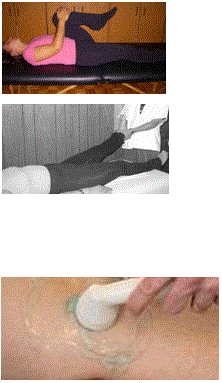PT = Placebo for patients with Hip OA
Reference:Bennell KL1, et al Effect of physical therapy on pain and function in patients with hip osteoarthritis: a randomized clinical trial. JAMA. 2014 May 21;311(19):1987-97.
In this high quality RCT, one group of patients with symptomatic hip OA received 10 treatments of multi-modal PT and the second group received sham ultrasound (US) & gel for 12 weeks; twice in the first week, once weekly for 6 weeks, then once every 2 weeks.
The initial 2 sessions of contact with the PT were 60 minutes in duration. The remainder were 30 minutes.
Experienced PTs provided all treatments which included education and advice, manual therapy, home exercise, and gait aid if appropriate.
The sham treatments were also provided by experienced PTs which involved the application of inactive ultrasound and water-based blue gel over the anterior and posterior hip region. During the 6-month follow-up, the patients in the sham group were also instructed on gently applying the gel (placebo) for 5 minutes 3 times weekly.
Average hip pain intensity in the past week was measured using the VAS, using a 100 mm horizontal line, for which 0 mm represented no pain and 100 mm, the worst pain possible.
The Horrifying Results:
After 3 months, the mean baseline pain score in the PT group degreased by 19mm and the pain score for the sham US & gel group decreased by 23mm. Meaning, the sham US & gel group did in fact bit better in pain scores than the comprehensive PT group (not statistically significant).
After 9 months, 38% in the PT group and 39% in the sham US & gel group reported improved pain relief.
In function, the PT group improved by a mean of 5.2 units while the sham US & gel group improved by 5.5 units. Again, meaning there were no differences between PT or sham US & gel.
After 9 months, 38% in the real PT group and 27% in the sham PT group reported improved function.
Basic conclusion: Among adults with painful hip OA, PT did not result in greater improvement in pain or function when compared to sham treatments, raising questions about the value of PT on patients with hip OA.
Personal Comments: What we can surely conclude with is that the US and the blue gel were good placebos where the patients truly believed in their therapeutic value.
The important thing is that the sham therapy was provided by attentive PTs who spent time with them who also provided direct skin contact and stimulation.
The researchers hypothesize that the sham US & gel patients did well because the PT had time to talk to them and re-assure them while “wasting time” moving ultrasound gel around. Whereas the other PTs were so busy providing “real” treatments such as mobs and prescribing detailed exercises that they had little time to calmly sit down with the patient and just talk to them.
Oh…what a powerful brain we have!
I still find it amusing that clinic owners hire PTs based on which level manual therapy they have which I find frankly irrelevant!
If there is ever a single study that will demonstrate that those with extensive manual therapy skills get better outcomes than those without, I will eat my words. So, it really doesn?t matter if you apply US gel on patients or do this amazing mob, just talk to them confidently and re-assure them.
Important note: I don’t wish to sound like a hypocrite as I certainly practice and teach manual therapy on all my courses but I focus less on specificity and rely more on the patients’ feedback on what feels good.
We need to accept that PT manual therapy and treatments (e.g. the spreading of blue US gel on patients and other beeping machines) have only a bit of a mechanical effect, but chiefly a neurophysiological effect.
Posted on: July 03, 2015
Categories: Hip


